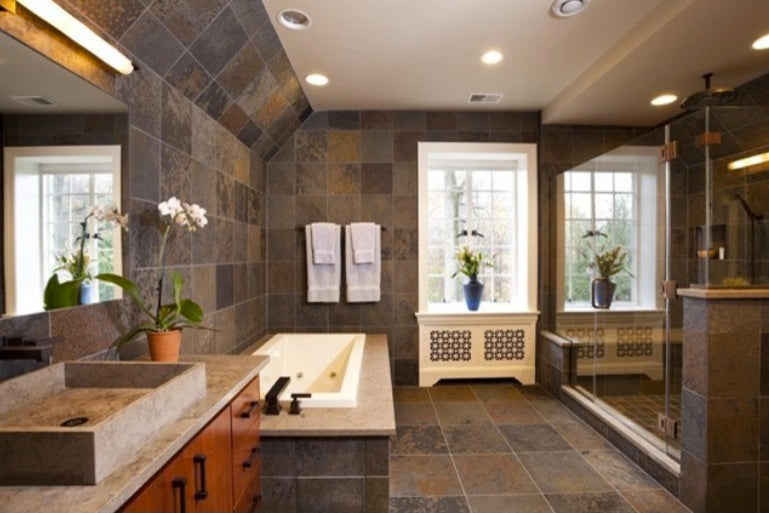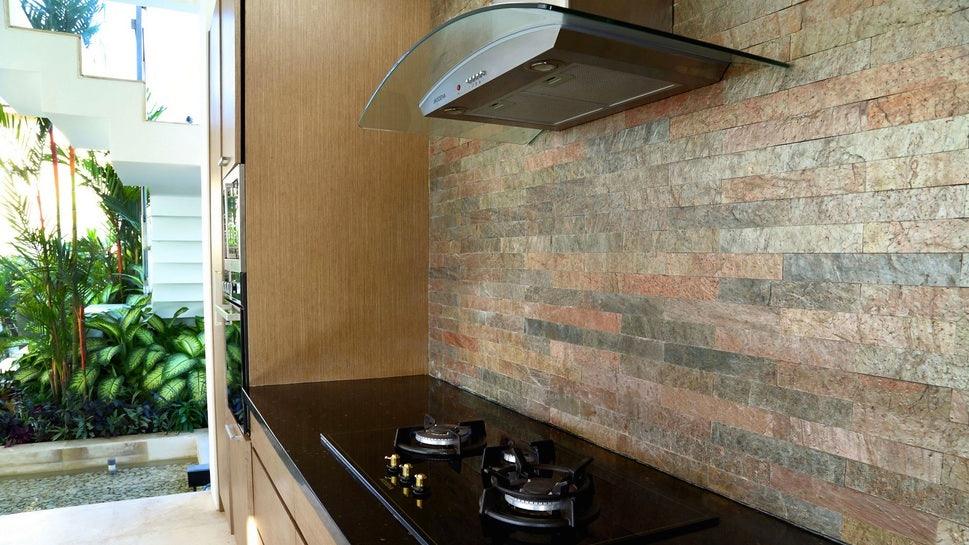Your Cart is Empty
Notebooks, pencils, backpacks -- August is a time when school supplies hit the shelves; and parents and kids alike stock up to prepare for the new year. Parents get their clean house back, and kids get to start off the new school year with a clean slate. Let's hope they did their summer reading assignments, right? At Architessa, we've prepared a quick read for you about natural slate, and our client spaces and collections that feature it. There's no need to take notes, we won't quiz you later. We just hope to see you later in one of our DC-metro area showrooms.
Before we jump into examples of slate tiles, let's look at slate as a natural material. What is natural slate? The textbook definition describes slate as:
"A fine-grained, foliated, homogeneous metamorphic rock derived from an original shale-type sedimentary rock composed of clay or volcanic ash through low-grade regional metamorphism. It is the finest grained foliated metamorphic rock."
Huh? Come again? Because some of us slept through first period science class, let's pull apart the definition one layer at a time.

In layman's terms, slate is a foliated or leaf-like rock, that was once one form of rock but changed to another because of heat and pressure. Typically found on the side of a mountain, slate is sedimentary because it is made of bits of sediment from other rocks, clay and ash carried by wind or rain water. Over time, the sediments harden and form irregular layers. This hardening or change in physical form, due to natural elements like heat and pressure, is known as metamorphism. Let's pull back a few more layers, and talk more about foliation and how it applies to slate tile.

The leaf-like foliation in slate is also called the cleavage. Middle school boys everywhere are giggling. Based on how minerals like quartz and sometimes graphite like what's use in a No. 2 pencil are compressed, and how the rock plates regrow, determines the type of cleavage that forms. When natural slate becomes tile, that cleavage is known as the cleft. It can be left natural, where you feel the uneven planes underfoot. Or the cleft can be honed or sanded down so that the level change and thickness are more consistent from tile to tile. Other surface treatments also include: antiqued, cobbled, brushed and tumbled.
Whew! Still with us? Let's switch from Geology to Geography. Slate is sourced from different areas of the world. Most of Europe's slate, for example, comes from Spain. They produce and export 90 percent of the region's natural slate used for roofing or flooring. European countries that are lesser known but also offer slate quarries are Belgium, Germany, Italy and Wales. Pictured above and below, is natural slate on a mountainside near the Mosel River in Rhineland, Germany.
 Natural slate on a mountainside near Eltz Castle and the Mosel River in Rhineland, Germany. Photo via Libby Turner Dickstein
Natural slate on a mountainside near Eltz Castle and the Mosel River in Rhineland, Germany. Photo via Libby Turner Dickstein 
Knowing that Brazil is the second-largest resource for slate in the world, here are two designer spaces that feature slate from the area: Brazilian Black slate, and Brazilian Multi-colored slate. In both cases, the rough slate tile takes on an unexpectedly clean aesthetic.
What would you do if a tree fell on your house? Our Arlington, VA client purchased his home with the notion to renovate, and after a fallen tree damaged most of his new investment, he decided to start with a clean slate. With the help of Randall Mars Architects and Builder Gruver Cooley, the 1970's home took on new life with a contemporary style that features natural material selections in keeping with the home's natural setting.
 A mid-century modern, contemporary rebuild, Randall Mars Architects, and Builder Gruver Cooley
A mid-century modern, contemporary rebuild, Randall Mars Architects, and Builder Gruver CooleyThe exterior and interior of the home blends aspects of the old structure with a new addition. It also blends material choices together well, balancing extremes like: hard and soft, or cool and warm.

In the kitchen, the hard angles of the cabinetry and floors are softened by round light fixtures and natural light. Our 12"x24" Brazilian Black slate in a natural cleft finish was used in a herringbone pattern throughout the first floor of the home. Here, the choice to keep the lines of the tile parallel and and perpendicular to the upper and lower cabinets keeps the overall design clean and clutter-free.

The tongue-and-groove ceilings above and the natural slate tile below continue from the kitchen into the dining space. The cool black and grey natural variation in the floors is balanced by the warmth of the stained pine ceiling and the blonde natural wood casework.

That warmth carries into the master bath as well, not only because of the wood vanity and casework, but because of the slate tile. While slate tile is naturally cold under foot, it conducts heat well. Using in-floor heating warms the tile in a space where you often walk barefoot. The slate in the master bath is a honed finish instead of the natural cleft used in the other spaces. Again, a wise choice when barefoot. Not only the finish but the pattern and size differ slightly from the other spaces in the home. Throughout the rest of the house, our client spared no expense. The cost is often a critique of natural slate. However, adding natural stone tile like slate adds value to any renovation. To protect and maintain that investment, it's important to seal the tile once a year, to avoid staining or sun damage. In this client's home, flooded with natural light, sealing is a must.
The architecture and remodeling firm, Case Design, partnered with Architessa to create a rustic but luxurious master bath retreat. The design was featured in Trends Magazine after being voted a Top 50 American Bathroom. With a lodge feel, the space is great for a long hot bath during a cold Washington D.C. winter.
 Architessa's Brazilian Multi-color slate, designed by Case Design
Architessa's Brazilian Multi-color slate, designed by Case DesignThe floors and walls are done in our 12"x12" Brazilian Multi-color slate. Because the tile has a wide range in color, it was important to only use one field tile size to keep the design from getting too busy. Using a single tile size also allowed the natural color variation, from greys and greens to tans and golds, to speak for itself. Speaking to other aspects of the design, like the layout or the hardware finishes, Case Design considered each deceptively simple detail in a thoughtful way:

Just as slate tile can have a wide range of color variation from tile to tile, Architessa offers a wide range of slate tile options, from field sizes to cladding. We've already schooled you in slate as a natural element and how our clients used it among other design elements; but for a little extra credit, check out a few of our other slate tile collections:
Copper Quartzite Slate
Slate tile doesn't have to come in just large format field sizes. Here, our smaller-scale slate Strip Cladding in the color Copper Quartzite adds a range of texture and color as a backsplash behind a stove and range hood.
 Architessa's Copper Quartzite slate, image via islandstone.com
Architessa's Copper Quartzite slate, image via islandstone.com

